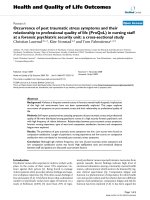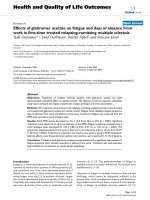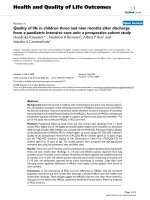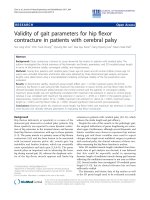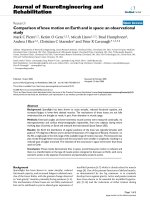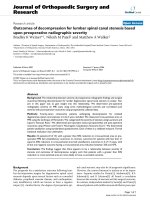Báo cáo hóa học: " Fabrication of Highly Ordered Polymeric Nanodot and Nanowire Arrays Templated by Supramolecular Assembly " pot
Bạn đang xem bản rút gọn của tài liệu. Xem và tải ngay bản đầy đủ của tài liệu tại đây (351.57 KB, 6 trang )
NANO EXPRESS
Fabrication of Highly Ordered Polymeric Nanodot and Nanowire
Arrays Templated by Supramolecular Assembly Block Copolymer
Nanoporous Thin Films
Xikui Liu Æ Manfred Stamm
Received: 18 October 2008 / Accepted: 27 January 2009 / Published online: 19 February 2009
Ó to the authors 2009
Abstract Realizing the vast technological potential of
patternable block copolymers requires both the precise
controlling of the orientation and long-range ordering,
which is still a challenging topic so far. Recently, we have
demonstrated that ordered nanoporous thin film can be
fabricated from a simple supramolecular assembly
approach. Here we will extend this approach and provide a
general route to fabricate large areas of highly ordered
polymeric nanodot and nanowire arrays. We revealed that
under a mixture solvent annealing atmosphere, a near-
defect-free nanoporous thin film over large areas can be
achieved. Under the direction of interpolymer hydrogen
bonding and capillary action of nanopores, this ordered
porous nanotemplate can be properly filled with phenolic
resin precursor, followed by curation and pyrolysis at
middle temperature to remove the nanotemplate, a perfect
ordered polymer nanodot arrays replication was obtained.
The orientation of the supramolecular assembly thin films
can be readily re-aligned parallel to the substrate upon
exposure to chloroform vapor, so this facile nanotemplate
replica method can be further extend to generate large
areas of polymeric nanowire arrays. Thus, we achieved a
successful sub-30 nm patterns nanotemplates transfer
methodology for fabricating polymeric nanopattern arrays
with highly ordered structure and tunable morphologies.
Keywords Supramolecular assembly Á
Nanoporous template Á Hydrogen bonding Á
Polymeric nanodot arrays
Introduction
Precise fabrication of large areas of ordered nanoscale
structures is essential for microelectronic and information
technology, the broad scope of top-down processes,
including conventional immersion lithography, extreme
ultraviolet lithography, and soft lithography have been
proposed to meet the demands of devices miniaturization,
these endeavors have enabled the lateral dimensions of
devices to be readily shrunk below 100 nm [1–3]. How-
ever, as the lateral dimension goes smaller and smaller,
these ‘top-down’ approaches become extremely difficult
and expensive, hence, other methodologies of creating
nanostructures are of great interesting if they can offer
advantages in reduced production cost, smaller feature
sizes, and more complex nanopatterns. Nanofabrication via
block copolymer self assembly represents one of the most
powerful candidates, and is now taking as the most
promising methodology for next-generation lithography
[4–6], mainly due to their intrinsic nanoscale dimensions,
facile synthesis, and strict control of architecture. Ever
since the self assembly of block copolymers was intro-
duced as a powerful ‘bottom-up’ route to well-organized
nanostructures decade ago, many efforts have been devo-
ted: as through chemical modification of the block
copolymer structure to achieve special functionalities,
exploring electric fields, and interfacial interactions to
X. Liu (&) Á M. Stamm (&)
Department of Nanostructured Materials, Leibniz Institute
of Polymer Research Dresden, Hohe Str. 6, 01069 Dresden,
Germany
e-mail: ;
M. Stamm
e-mail:
X. Liu
College of Polymer Science and Engineering, Sichuan
University, Sichuan 610065, China
123
Nanoscale Res Lett (2009) 4:459–464
DOI 10.1007/s11671-009-9263-4
control the orientation, and utilizing solvent induced
ordering, salt complexes, and shear fields to achieve ordered
arrays [7–10]. Among which solvent annealing is of par-
ticularly beneficial mainly due to their mild process
condition and no need for additional complicated apparatus,
and now it has turn out to be a very simple while robust
approach to generate almost defect-free microphase sepa-
ration structures in BCP thin films [11–13]. Even more, it
appears to be the single possible way for thermal lible
systems such supramolecular block copolymers based on
noncovalently bonding. Further research revealed the use of
a co-solvent atmosphere, will enables one to enhancing the
ordering process ever further [14, 15]. However, a critical
drawback of solvent annealing is that BCP thin film often
de-wets its substrate during solvent exposure as have been
already pointed out by several researchers [16–19]. This
makes it is very difficult to obtain uniform and ordered BCP
thin film over a macroscopic area without the direction of
additional external fields. In many cases, realizing the vast
technological potential of block copolymers requires both
the precise controlling of the orientation and long-range
ordering, however, weakness still remains, so far, only few
works have reported to achieve highly ordered thin film
nanotemplates, and the control of well-organized structures
over large scale is still a challenging topic.
In recent decade, Ikkala and ten Brinke have thoroughly
demonstrated that well-ordered nanostructures in the bulk
may be fabricated through supramolecular assemblies
(SMA) of low molecular amphiphiles and block copoly-
mers [20, 21]. The amphiphiles can be physically bonded
to homopolymers and block copolymers using noncovalent
interactions, this complexation can lead to the formation of
supramolcecular block copolymer which can further
assembled into hierarchy nanostructures with various
responsive properties. More recently, we have demon-
strated that ordered nanoporous thin film can be fabricated
from a similar approach based on the supramolecular
assemblies of block copolymers PS-PVP and small mole-
cule (2,4-Hydroxybenzeneazo benzoic acid, HABA) [22–
26], the SMA thin films demonstrated hexagonal cylindri-
cal morphology with PS form the matrix. Solvent annealing
in dioxane can enhance the ordering of thin films micro-
phase separation, following extraction of HABA with
selective solvent methanol results in a nanoporous thin
films. The channels can be filled with metal, for example,
nickel, by electrochemical deposition to fabricate an array
of ordered metal nanodots or nanowires with some defects
appear in the array due to the nonuniform electrodeposition
kinetics of the metal clusters in nanochannels [23].
In this article, we further investigate the PS-PVP/HABA
supramolecular assembly system in order to achieve a
highly ordered morphology and to explore a high definition
nanotemplate replication method for fabrication of highly
ordered polymeric nanodots and nanowire arrays. We will
demonstrate that under a mixture solvent annealing atmo-
sphere (with the dedicating choosing of an additional
nitromethane as a selective solvent for the minor compo-
nent), a near-defect-free nanoporous thin films with long-
range ordering over a large areas can be achieved. Taking
aim at high definition nanotemplate transfer technique
which is another daunting obstacle to the application of the
nanoporous template, we will further show that under the
direction of the capillary action and hydrogen bonding, this
ordered nanoporous template can be perfectly transferred,
and thus achieved a methodology for the preparation of
highly ordered sub-30 nm polymeric nanodot and nanowire
arrays.
Experimental
Materials
Poly(styrene-block-4-vinylpyridine) (PS-PVP), with Mn
PS 4000 g/mol, PVP 5600 g/mol, Mw/Mn 1.06) for both
blocks, was purchased from Polymer Source Inc. A soluble
low-molecular-weight phenolic resin precursor solution
was prepared from phenol and formaldehyde using a basic
polymerization method [20]. The final product was redis-
solved in Ethanol before use as dip coating solution. 2-(4-
Hydroxybenzeneazo) benzoic acid (HABA) was purchased
from Sigma-Aldrich. Solvents 1,4-dioxane, chloroform,
methanol, and dichloromethanes were purchased from
Acros Organics and used as supplied.
Fabrication of Ordered Nanodots and Nanowire Arrays
PS-PVP and HABA (1 mol of HABA and 1 mol of 4-
vinylpyridine monomer unit) were dissolved separately in
1,4-dioxane. PS-PVP solution was slowly added dropwise
to HABA solution while heating to 95 °C in an ultrasonic
bath. The resulting solution was kept at least overnight to
complete hydrogen-bond formation. Thin films were pre-
pared by dip coating from the filtered solutions. Additional
1,4-dioxane/nitromethane mixture solvent vapor annealing
of a thin film was applied to improve the order of nanod-
omains. Alternatively, the samples were treated in vapors
of chloroform to arrange parallel alignment of the nanod-
omains. Nanoporous thin film was fabricated by selective
extraction of HABA with methanol. The nanoporous tem-
plate was dip coating from the ethanol solution of phenolic
resin precursor, the thin film was sequentially cured by
exposure to formaldehyde gas at 100 °
C for 4 h. The cured
film was finally pyrolysis at middle temperature (heating to
450 ° C in 2 h and keep 2 h), to remove the PS-PVP and
resulted ordered nanodots arrays (Fig. 1).
460 Nanoscale Res Lett (2009) 4:459–464
123
Characterization of the Ordered Thin Films
The thickness of the polymer films was measured by a
SE400 ellipsometer (SENTECH Instruments GmbH, Ger-
many) with a 632.8 nm laser at a 70° incident angle.
Atomic force microscopy (AFM) imaging was performed
using a Dimension 3100 scanning force microscope (Dig-
ital Instruments, Inc.,) in the tapping mode. Analysis of the
AFM images (fast Fourier transform) was performed with
WSxM software (Nanotec Electronica).
Result and Discussions
The as-deposited PS-PVP/HABA thin film form cylindrical
phase separation normal to the substrate, with poor lateral
ordering. Due to the thermal liability of hydrogen bonding,
solvent vapor annealing is an elegant approach to promote
BCP ordering, in the previous study, dioxane was chosen as
the annealing solvent, here we dedicating chosen a 1,4-
dioxane/nitromethane mixture solvent annealing in order to
further enhances the long-range ordering in relatively short
time. After being annealed in a dioxane/nitromethane
mixture solvent for about 24 h, the films were taken out
and rinsed in methanol for 5 min to destroy the hydrogen
bonding and removes selectively HABA from thin film,
and resulted a nanoporous thin film, the AFM revealed the
orientation order is only of short-range, this is also apparent
from a smashed ring in the FFT plot (Fig. 2).
However, further prolonging solvent annealing time to
about 72 h in mixture atmosphere lead to a dramatically
increase in the long-range ordering of the thin film, AFM
image clearly identified a near-defect-free ordered arrays of
highly ordered hexagonal structure with all pores oriented
perpendicular to the substrate (Fig. 3), the Fourier trans-
form plot of the corresponding AFM phase image is shown
in the inset, the six sharp first-order peaks clearly indicate
the presence of a highly ordered hexagonal structures, this
higher order peaks attest to the high degree of order within
the thin film. The mean center-to-center distance of the
nanopores based on the AFM image is about 30 nm.
During solvent annealing, PS, and P4VP/HABA, blocks are
swelled by dioxane vapor and tend to organize into a
Fig. 1 Scheme of the
fabrication of highly ordered
polymeric nanodot and
nanowire arrays templated by
nanoporous thin films
Fig. 2 AFM images of nanoporous thin films a height image, b phase
image. Mixture solvent annealing for 24 h, and washed with
methanol. Thin film 45 nm thick, lateral scale 1500 nm 9 1500 nm.
The inset is the FFT plot of the image
Nanoscale Res Lett (2009) 4:459–464 461
123
ordered structures, however, this process is restrained by
dioxane in a certain extent due to the good solubility of
dioxane for all the blocks, with the addition of nitrometh-
ane which is a good solvent only for the minor PVP/HABA
block, the repulsion between the PS and P4VP/HABA
domains is enhanced, a fast and highly ordered defect-free
microphase separation structure is achieved.
These nanoporous thin films can be used as scaffolds for
fabricating organic, inorganic, and metal nanostructures.
Compared with the well studied inorganic and metal
nanostructures, organic (polymeric) nanostructures remains
less researched, despite their great potential in catalysis and
membrane separation. Here, we demonstrated that highly
ordered phenolic resin nanodot and nanowire arrays can be
prepared through perfect replication of the ordered nano-
template with the direction of hydrogen bonding and the
capillary action of nanopores [27]. The above prepared
nanoporous thin films were immersed in the phenolic resin
precursor/ethanol solution, the nanopores were immedi-
ately filled by phenolic precursors due to the capillary
action of cylindrical nanopores the formation of inter-
polymer hydrogen bonding complex between the PVP in
the inner pore surface of the nanotemplate and the phenolic
resin. As ethanol is just a good solvent for minor compo-
nent PVP, while is a nonsolvent for the matrix composed of
PS, thus, the nanoporous templates are maintained during
the dip coating process. When the template was drop from
the precursor solution, the ethanol vaporized and the phe-
nolic resin precursor were maintaining inside the
nanopores. After curation with formaldehyde, the filled
nanotemplates were then pyrolysed at middle temperature
(heating to 450 °C in 2 h and keep 2 h), this temperature is
enough to degrade PS-PVP nanotemplate, while the phe-
nolic resin can still maintained. AFM height image
revealed, after pyrolysis, highly ordered discrete phenolic
resin nanodots arrays with uniform diameter can be
observed (Fig. 4), of special interest is that the original
highly ordered structure of nanoporous thin film was
almost maintained throughout the nanotemplate transfer
process and thus resulted a perfect nanotemplate transfor-
mation; the average center-to-center distance between the
nanodots was 30 nm, which was identical to that of the
original porous nanotemplate.
In addition to preparation of nanodots arrays, we further
extend this facile nanotemplate replica method to fabricate
polymeric nanowire arrays. A special advantage of the
supramolecular assembled PS-PVP/HABA system we used
here is that the orientation of the phase separation can be
reversibly switched from the perpendicular to parallel ori-
entation and vice versa upon exposure to 1,4-dioxane or
chloroform vapor, respectively. Thus, instead of dioxane
vapor, the PS-PVP/HABA supramolecular assembly thin
film was annealed in a saturated chloroform vapor for short
time of 15 min to achieve re-alignment. After rinsing with
methanol, the AFM revealed that most of cylindrical
microdomains orientation was re-alignment parallel to the
substrate, still it was clear that 15 min is not enough to
fulfill the re-alignment process and thus the coexistence of
normal and parallel alignments of nanodomains were
observed (Fig. 5a). Followed the same template transfer
process, this nanotemplate was dip coating from phenolic
resin precursor solution, and followed by curation and
middle temperature pyrolysis, large areas of short poly-
meric nanowires with nanodots mixture were formed
(Fig. 5b), which was similar to the original nanotemplate.
Further prolonging the chloroform solvent annealing
time to 30 min is enough to fulfill the re-alignment trans-
formation process, after rinsing with methanol, the AFM
Fig. 3 AFM images of the nanoporous thin films a height image, b
phase image, c enlarged height image. Mixture solvent annealing
72 h, and washed with methanol. Thin film 45 nm thick, lateral scale
1500 nm 9 1500 nm. The inset is the FFT plot of the AFM image
Fig. 4 AFM images of highly ordered polymeric nanodots arrays
from nanoporous thin film after pyrolysis. a Height image, b Phase
image. Lateral scale 1500 nm 9 1500 nm. c Enlarged height image
462 Nanoscale Res Lett (2009) 4:459–464
123
revealed that all the cylindrical microdomains were ori-
ented parallel to the substrate(Fig. 6a), and thus after
deposition and middle temperature pyrolysis, a longer
nanowire arrays which was identical to that in the original
nanotemplate can be achieved (Fig. 6b).
Conclusion
In summary, we have provided a general route to fabricate
highly ordered polymeric nanodot and nanowire arrays
using supramolecular assembled block copolymer thin film
as nanotemplates through the interpolymer hydrogen
bonding capillary action. The as-deposited PS-PVP/HABA
thin film formed randomly hexagonally packed cylindrical
phase separation structures, with the dedicating choosing of
mixture solvent annealing atmosphere (dioxane as good
solvent for both blocks and an additional nitromethane as a
selective solvent only for the minor component PVP/
HABA), a near-defect-free nanoporous thin film with long-
range ordering over a broader range of length scales can be
achieved, extraction of HABA microdomains resulted in
highly ordered nanoporous thin films. Under the direction
of interpolymer hydrogen bonding and the capillary action
of nanopores, the nanotemplate can be properly filled with
phenolic resin precursor, followed by curation and pyro-
lysis at middle temperature which will selectively degrade
the PS-PVP block copolymer nanotemplate, a perfect
ordered nanodot arrays replication was obtained, thus
resulted in an excellent and efficient transformation of the
nanoporous template to functional polymeric nanodot
arrays. The orientation of the supramolecular assembly thin
films can be readily re-alignment from the perpendicular to
parallel the substrate upon exposure to chloroform vapor,
and thus this facile nanotemplate replica method can be
further extend to generate large areas of polymeric nano-
wire arrays. Thus, we have achieved a successful sub-
30 nm patterns nanotemplates transfer methodology for
fabricating polymeric nanopattern arrays with tunable
morphology and lateral spacings.
References
1. G.M. Whitesides, B. Grzybowski, Science 295, 2418 (2002). doi:
10.1126/science.1070821
2. I.W. Hamley, Angew. Chem. Int. Ed. 42, 1692 (2003). doi:
10.1002/anie.200200546
3. E. Hutter, J.H. Fendler, Adv. Mater. 16, 1685 (2004). doi:
10.1002/adma.200400271
4. C. Parka, J. Yoonb, E.L. Thomas, Polymer (Guildf) 44, 6725
(2003). doi:10.1016/j.polymer.2003.08.011
5. M. Li, C.A. Coenjarts, C.K. Ober, Adv. Polym. Sci. 190, 183
(2005). doi:10.1007/12_003
6. C.K. Ober, A.H. Gabor, P. Gallagher-Wetmore, R.D. Allen, Adv.
Mater. 9, 1039 (1997). doi:10.1002/adma.19970091309
7. S.B. Darling, Prog. Polym. Sci. 32, 1152 (2007). doi:10.1016/
j.progpolymsci.2007.05.004
8. S. Sakurai, Polymer (Guildf) 49, 2781 (2008). doi:10.1016/
j.polymer.2008.03.020
9. E. Huang, L. Rockford, T.P. Russell, C.J. Hawker, Nature 395,
757 (1998). doi:10.1038/27358
10. J. He, J. Wang, J. Xu, R. Tangirala, D. Shin, T.P. Russell, X. Li,
J. Wang, Adv. Mater. 19, 4370 (2007). doi:10.1002/adma.2006
02877
11. G. Kim, M. Libera, Macromolecules 31, 2569 (1998). doi:10.1021/
ma971349i
12. C. De Rosa, C. Park, E.L. Thomas, B. Lotz, Nature 405, 433
(2000). doi:10.1038/35013018
13. S. Kim, M. Minsner, T. Xu, M. Kimura, T.P. Russell, Adv. Mater.
16, 226 (2004). doi:10.1002/adma.200304906
14. C. Liang, K. Hong, G.A. Guiochon, J.W. Mays, S. Dai, Angew.
Chem. Int. Ed. 43, 5785 (2004). doi:10.1002/anie.200461051
15. J. Bang, S.H. Kim, E. Drockenmuller, M.J. Misner, T.P. Russell,
C.J. Hawker, J. Am. Chem. Soc. 128, 7622 (2006). doi:10.1021/
ja0608141
16. J. Peng, Y. Han, W. Knoll, D.H. Kim, Macromol. Rapid Com-
mun. 28, 1422 (2007). doi:10.1002/marc.200700206
17. T.H. Kim, J. Hwang, W.S. Hwang, J. Huh, H.C. Kim, S.H. Kim,
J.M. Hong, E.L. Thomas, C. Park, Adv. Mater. 20, 522 (2008).
doi:10.1002/adma.200700651
Fig. 5 a AFM height images of thin film nanotemplate, after re-
alignment using chloroform annealing for 15 min. b Height images of
the resulted short polymeric nanowire arrays replica after pyrolysis.
Lateral scale 2000 nm 9 2000 nm
Fig. 6 a AFM height images of thin film nanotemplate, after re-
alignment using chloroform annealing for 30 min. b AFM height
images of polymeric nanowire arrays replica after pyrolysis. Lateral
scale 2000 nm 9 2000 nm
Nanoscale Res Lett (2009) 4:459–464 463
123
18. T.H. Epps, D.M. De Longchamp, M.J. Fasolka, Langmuir 23,
3355 (2007). doi:10.1021/la062707q
19. J. Peng, D.H. Kim, W. Knoll, Y. Xuan, B. Li, Y. Han, J. Chem.
Phys. 125, 064702 (2006). doi:10.1063/1.2219446
20. J. Ruokolainen, R. Makinen, M. Torkkeli, T. Makela, R. Serimaa,
G. ten Brinke, O. Ikkala, Science 280, 557 (1998). doi:10.1126/
science.280.5363.557
21. S. Valkama, H. Kosonen, J. Ruokolainen, T. Haatainen, M.
Torkkeli, R. Serimaa, G. ten Brinke, O. Ikkala, Nat. Mater. 3, 872
(2004). doi:10.1038/nmat1254
22. A.W. Fahmi, H.G. Braun, M. Stamm, Adv. Mater. 15, 1201
(2003). doi:10.1002/adma.200304995
23. A. Sidorenko, I. Tokarev, S. Minko, M. Stamm, J. Am. Chem.
Soc. 125, 12211 (2003). doi:10.1021/ja036085w
24. I. Tokarev, R. Krenek, Y. Burkov, D. Schmeisser, A. Sidorenko,
S. Minko, M. Stamm, Macromolecules 38, 507 (2005). doi:
10.1021/ma048864i
25. M. Stamm, S. Minko, I. Tokarev, A. Fahmi, D. Usov, Macromol.
Symp. 214, 73 (2004). doi:10.1002/masy.200451006
26. D. Zschech, A.P. Milenin, R. Scholz, R. Hillebrand, Y. Sun, P.
Uhlmann, M. Stamm, M. Steinhart, U. Gosele, Macromolecules
40, 7752 (2007). doi:10.1021/ma071136l
27. S. Park, B. Kim, J.Y. Wang, T.P. Russell, Adv. Mater. 20, 681
(2008). doi:10.1002/adma.200701997
464 Nanoscale Res Lett (2009) 4:459–464
123


